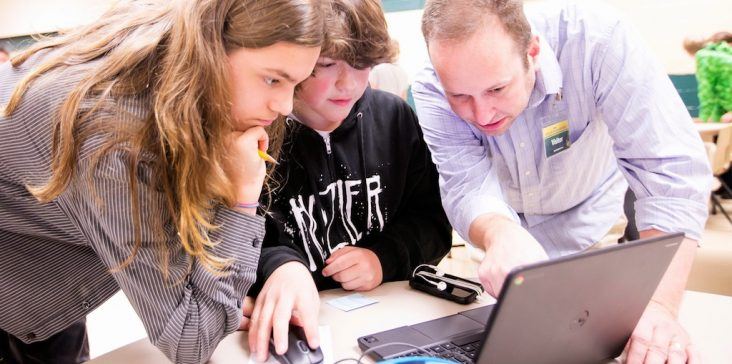UAFS ‘Renewal Zone’ program works with public school students on computer programming
by November 4, 2015 4:11 pm 366 views

UAFS professor Brian McLaughlan assists Alma Middle School students during a video game competition Nov. 3. The event was held through the Adopt-a-Professor program, an educational outreach initiative coordinated by the university’s Education Renewal Zone.
Editor’s note: Story information provided by the University of Arkansas at Fort Smith.
Alma Middle School students recently gathered around the laptop, watching as two students maneuvered their players – represented by black circles – on a pixelated two-dimensional football field.
The offensive player selected his play, and the quarterback threw the ball. The students — one playing as the receiver and one playing as the defender — guided their players toward the ball in hopes of catching or intercepting it. When the black circle of the receiver reached the spot where the ball landed, the word “CATCH” appeared at the top of the screen.
The game was complex and rewarding, and it was created by an Alma student through an engagement for Adopt-a-Professor, an educational outreach initiative coordinated by the University of Arkansas at Fort Smith’s Education Renewal Zone. The program pairs UAFS professors with elementary and secondary school teachers to provide collaborative and unique learning opportunities for students.
More than 90 Alma Middle School students spread across 30 teams gathered in the cafeteria at the middle school Nov. 3 to showcase video games they programmed and designed over the last several months. Students sampled games made by fellow students and voted on several award categories, including the most impressive, most creative, and most fun games.
The students created the games in one of Johnny Fortenberry’s six engineering technology and education classes with the help of Dr. Brian McLaughlan, assistant professor of computer and information sciences at UAFS.
COMPUTER CODING PUSH
McLaughlan, along with students from the computer science program at UAFS, visited the students two other times this semester to assist students develop their games on Scratch, a streamlined game development software created by the Massachusetts Institute of Technology.
“Everything is becoming computerized, so being able to write computer code lets people actually communicate with and control their world,” McLaughlan said. “Even if the students don’t plan to be programmers, their problem solving skills have been given a workout by this project. I had a student that asked me how to make a crab breathe fire in his game. When I nudged him in the right direction, it was awesome to see the lightbulb go on in his eyes.”
The UAFS program fits in with the push by Gov. Asa Hutchinson (R) to boost computer coding education in the state. The governor’s legislative push included funding and direction for such education. A recent commentary from the governor’s office noted that Arkansas schools more than doubled the number of students enrolled in high school computer science classes. There are more than 4,500 students enrolled in at least one of 14 coding courses. According to state data, the enrollment is up 260% compared to the previous year/
“To compete in any field in the 21st Century, you need computer skills. They’re almost as fundamental as reading, writing and arithmetic,” Hutchinson noted in a recent weekly column. “Quickly changing technology can leave unprepared workers out of a job. But here in Arkansas, by introducing students to computer science at an early age, we can give them a competitive advantage.”
FINDING A NICHE
When McLaughlan first tasked students to program games, 8th-grader Josh Cater saw an opportunity to fuse his love of football with his interest in programming.
“I really liked football, so I decided I wanted to make a football game because I play them at my house all the time,” he said. “I had been taking online programming courses outside of school, and whenever Dr. McLaughlan came, I decided this would be the perfect game.”
Cater’s game was voted the most impressive by his peers. A bouncing ball game reminiscent of Pong was voted the most fun, and a guessing game where the player attempts to pick which cup a ball is under was voted the most creative.
Plenty of other students have discovered an interest in programming through the engagement as well.
“I’ve enjoyed it a lot,” said London Blackwell, an eighth-grade female student who designed a game where the player is a butterfly and must dodge floating balloons. “It’s a way to express your creativity and for kids to have fun while learning at the same time.”
Fortenberry said he hopes the effort sparks interest in continued programming work.
“I think some of them may have found a niche,” Fortenberry said. “They’re thinking, ‘Hey, I like this.’ Maybe not for making games necessarily, but working with computers in other areas.”
